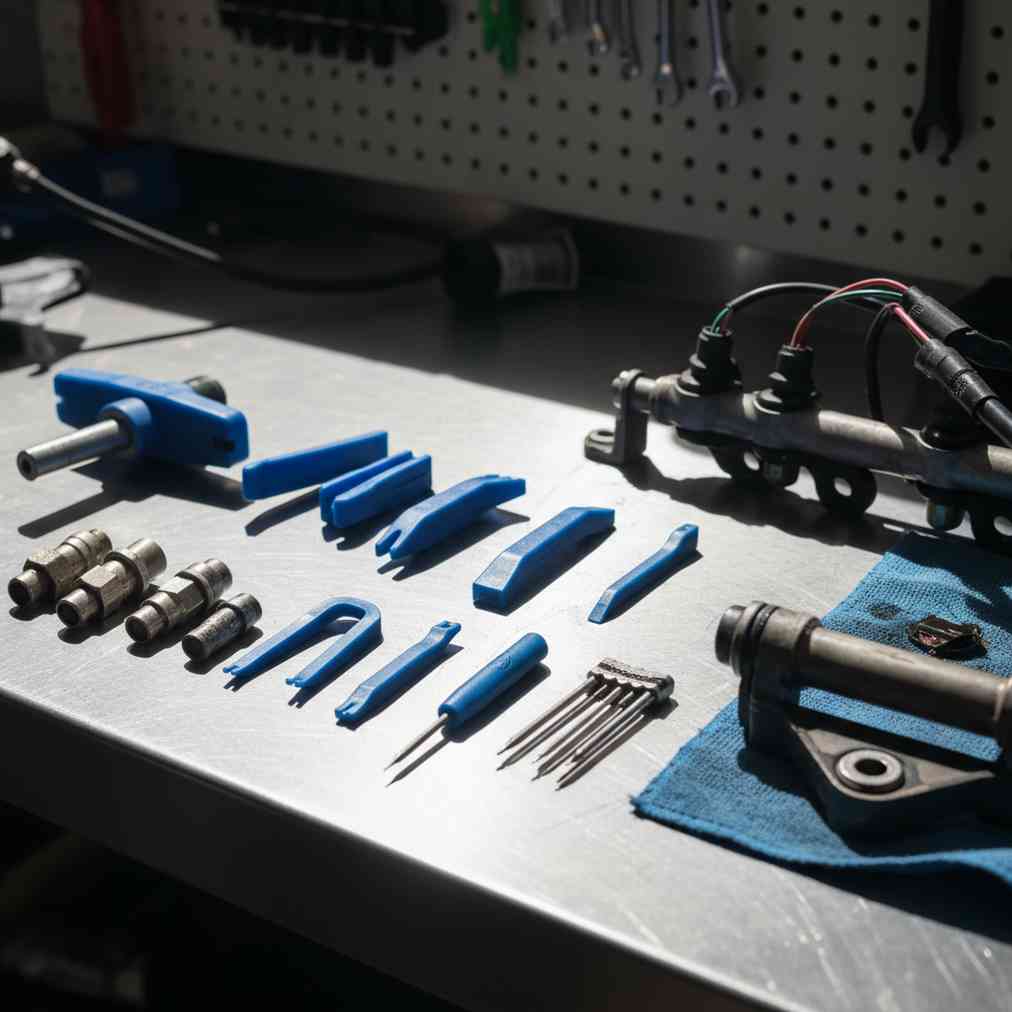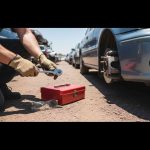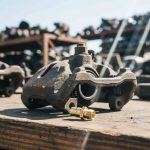Beyond Basic Tools: Professional-Grade Equipment for Junkyard Success
While a basic socket set and wrenches are essential, experienced parts pullers know that specialty tools make the difference between frustration and efficiency in salvage yards. These professional-grade instruments are specifically designed to handle the unique challenges of removing parts from vehicles that have been sitting in the elements, often with corroded fasteners and brittle plastic.
The golden rule among junkyard professionals is to “go cheap” with tools you bring to the yard, as they’re easily lost in the rough environment. However, investing in the right specialty tools can save hours of work and prevent costly damage to valuable parts.
Fuel System Specialists: Disconnect Tools That Actually Work
Fuel Line Disconnect Tool Sets are the unsung heroes of engine bay work. These specialized instruments are engineered to depress the internal locking tabs on quick-connect fuel line fittings without breaking the plastic or metal connector housing.
“If you attempt to disconnect [fuel lines] using other methods, you may cause more damage to the system. The tool is rather inexpensive and costs much less than replacing fuel lines that were not damaged.”
These tools are lifesavers when removing fuel rails, fuel pumps, or any part attached to a fuel line. Many modern fuel lines only disconnect with this specialty tool, making it an indispensable addition to your toolkit.
Interior and Exterior Trim Specialists
Automotive Trim Removal Tool Kits consist of plastic or nylon pry tools designed to safely separate interior and exterior trim panels without scratching paint or breaking brittle plastic tabs. Using metal pry bars on plastic trim almost guarantees damage and frustration.
- Door panels and interior trim
- Dashboard parts and console pieces
- Headliners and fabric panels
- Exterior body moldings and emblems
Panel Poppers work in conjunction with trim tools, specifically designed to lift and release automotive body and interior clips without damaging surrounding panel material. These dedicated tools excel at getting under clip heads to pop them out cleanly.
Electrical System Navigation Tools
Electrical Connector Pliers feature curved or angled tips designed to safely release various automotive electrical connectors. These specialized pliers apply pressure correctly to release locking mechanisms without crushing delicate connector housings.
They’re particularly valuable for disconnecting:
- Fuel injector wiring harnesses
- Spark plug coil connectors
- Sensor wiring in tight spaces
- ECU and module connections
Access and Precision Tools for Tight Spaces
| Tool | Primary Use | Key Advantage |
|---|---|---|
| Long-Reach Curved Pliers | Deep engine bay access | Grab loose bolts and hard-to-reach fasteners |
| Wobble Extension Set | Angled bolt access | Universal joint action for tight spaces |
| Ratcheting Wrenches | Continuous turning | Minimal movement required in confined areas |
Wobble Extension Sets feature a slight “wobble” or universal joint action that allows socket engagement when straight-line access is impossible. The slight angle capability makes them invaluable for bolts surrounded by other parts.
Ratcheting Wrenches allow continuous turning with minimal movement, saving immense time compared to constantly repositioning a standard wrench in tight spaces.
Cutting and Power Tools for Stubborn Parts
Heavy-Duty Diagonal Cutters provide a practical solution when parts are too difficult to unbolt. Professional salvage operators often find that cutting wiring harnesses or rubber hoses (after proper depressurization) is the fastest extraction method.
“It’s often easier to just cut fuel lines or wires and deal with the fittings later, so cutting tools can save a lot of time.”
Cordless Impact Wrenches have revolutionized junkyard efficiency. A mid-torque, battery-powered impact tool dramatically reduces physical effort and time for:
- Suspension parts removal
- Large subframe bolts
- Heavily rusted lug nuts
- Exhaust system fasteners
Modern trends favor cordless power tools over air-powered alternatives, eliminating the need for compressors while providing superior portability around the yard.
Visibility and Safety Equipment
A high-powered penlight or headlamp might seem basic, but it’s crucial for working under vehicles or deep inside dark engine bays. A quality headlamp keeps both hands free, which is essential when maneuvering tools in awkward positions.
Modern LED technology provides exceptional brightness in compact, affordable packages that won’t break the bank if lost in the yard.
Professional Tips and Best Practices
Research Before You Go: Knowing your target part ahead of time helps narrow down required tools, preventing multiple trips back to your vehicle. Understanding the specific removal procedures for your target parts can significantly improve efficiency.
Organization Matters: Bring small plastic bags and a marker to label removed fasteners. This simple practice prevents losing critical hardware during the extraction process.
Transportation Planning: A hand truck or dolly is recommended for transporting heavy tools and parts around the yard efficiently.
Safety Considerations for Fuel System Work
When dealing with fuel lines, safety is paramount. Always reduce fuel pressure by pulling the fuel pump fuse and running the engine until it stalls. Wear eye protection before disconnecting any fuel line, and ensure proper ventilation when working with fuel system parts.
Professional salvage operators emphasize that taking time for proper safety procedures prevents accidents and ensures a successful parts-pulling session.
Investment vs. Return: Why Quality Tools Matter
“I don’t want to drag your entire tool shop around the salvage yard… but you also don’t want to be missing the one tool you need for the job.”
The key is balancing tool quality with affordability. These specialty tools often cost less than the parts they help preserve during extraction. A $15 fuel line disconnect tool can save a $50 fuel rail from damage.
For those looking to sell their vehicle for cash instead of pulling parts, these tools also help maximize the value of parts removed before sale.
Modern Junkyard Trends and Technology
The salvage industry is evolving with modern vehicles featuring more complex quick-connect systems across fuel, oil, and AC lines. Advanced analytics are even being used by larger operations to track inventory and optimize yard layouts.
Professional mechanics increasingly rely on specialized tools designed for these modern systems, making traditional “universal” approaches less effective. The focus has shifted toward system-specific tools that work reliably with contemporary automotive engineering.
Building Your Professional Toolkit
Start with the most universally useful tools: fuel line disconnect sets, trim removal kits, and electrical connector pliers. These three categories address the majority of challenging extractions in modern salvage yards.
Gradually add specialized tools based on your most common target parts. If you frequently pull suspension parts, invest in a cordless impact wrench. For interior work, prioritize comprehensive trim tool sets and panel poppers.
Remember, these tools transform frustrating battles with stubborn parts into efficient, profitable ventures. The time saved and damage prevented quickly justify the modest investment in professional-grade specialty equipment.





Leave a Reply
You must be logged in to post a comment.